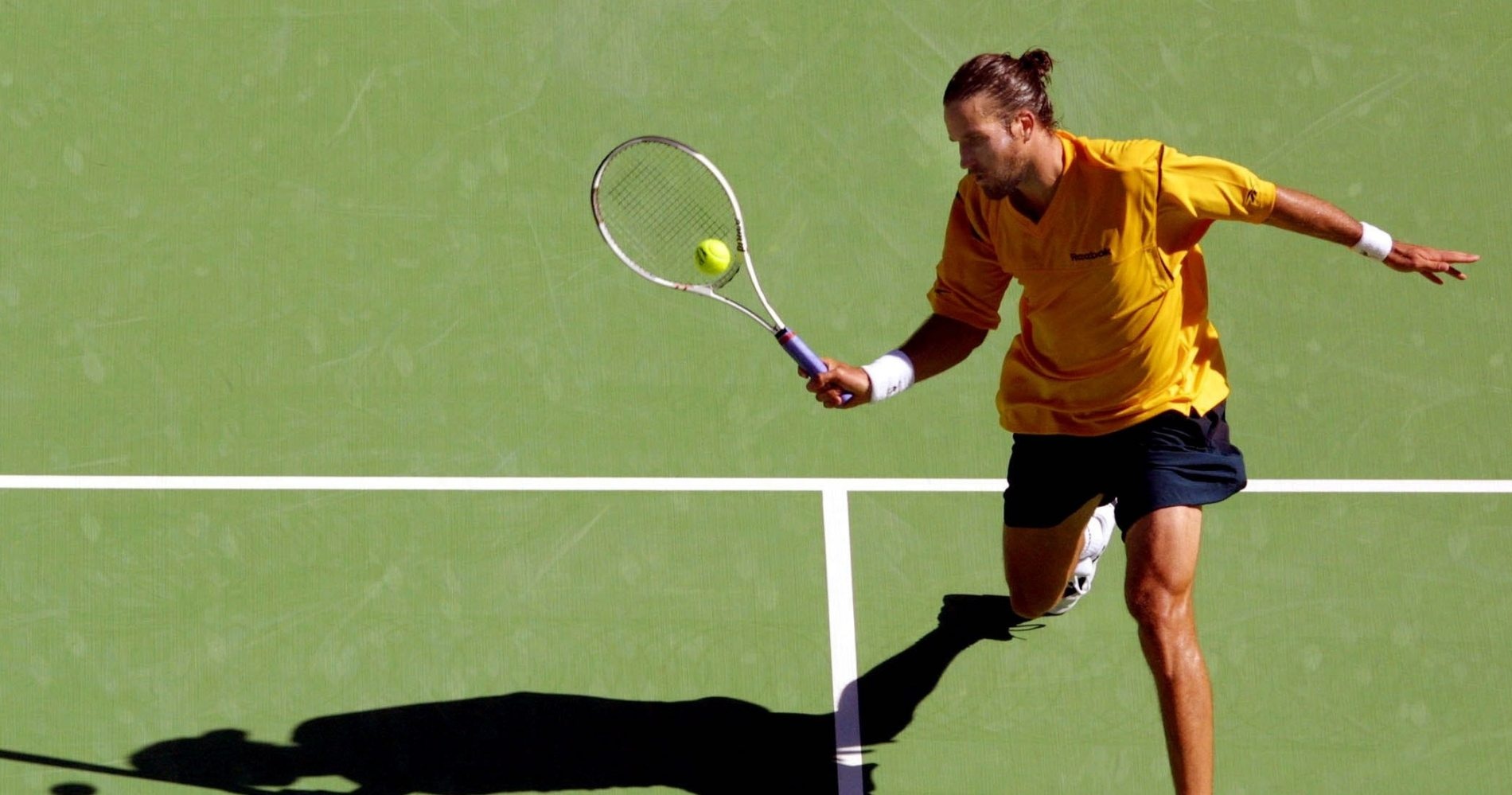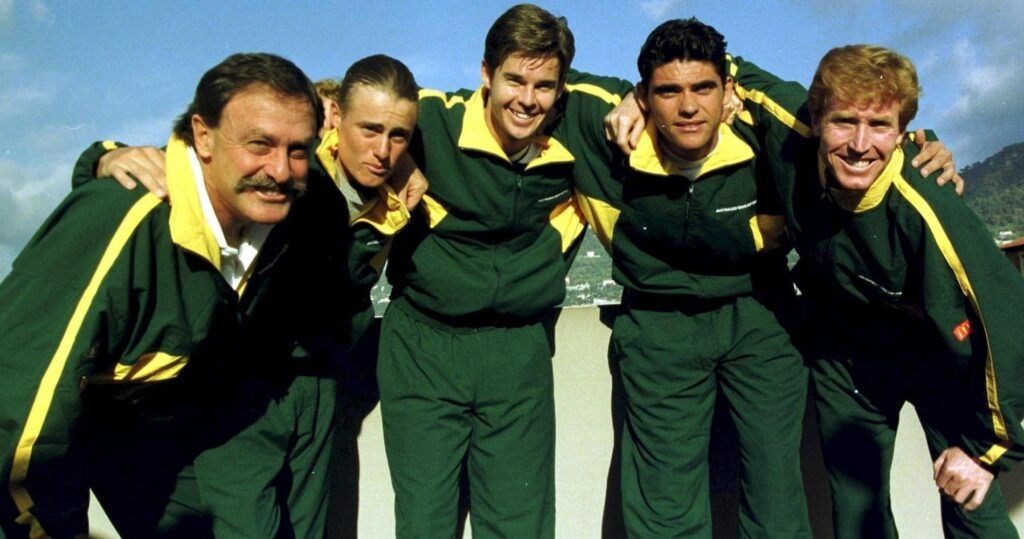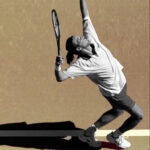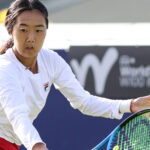July 18, 1999: The day Pat Rafter downed Todd Martin in an epic controversial Davis Cup clash
Every day, Tennis Majors takes you back in time to relive a tennis event which happened on this specific day. On July 18, 1999, the US Davis Cup captain wanted to replace Todd Martin with Pete Sampras but the neutral doctor denied the Americans request
 Todd Martin – On this day
Todd Martin – On this day
What happened exactly on that day?
On this day, July 18, 1999, in the Davis Cup quarter-finals, Todd Martin, representing the United States, played against Pat Rafter after his captain, Tom Gullikson, had tried to replace him in the last minute by Pete Sampras because of alleged sickness. This substitution was not allowed by the rules at the time without the approval of a neutral doctor. Although he was reportedly suffering from heatstroke, the American was deemed fit to play, and even managed to lead two sets to love, before Rafter came back to send the Australian team into the semi-finals, 4-6, 5-7, 6-3, 6-2, 6-4.
The players: Australian Pat Rafter and American Todd Martin
- Pat Rafter: The two-time US Open champion
Pat Rafter was born in 1972 and turned pro in 1991. The Australian had not achieved any remarkable results in his early career, claiming only one title before 1997, at the 1994 Manchester Open. He had reached his best ranking of No 21 in 1994 and had spent most of his time outside the top 40. In 1997, his career suddenly took off when he reached the semi-finals at Roland-Garros, defeated only by Sergi Bruguera (6-7, 6-1, 7-5, 7-6).
A few months later, after reaching two finals, in Indianapolis and Long Island, he claimed the US Open title to everybody’s surprise. It was only his second title ever. On his way, he had defeated Andre Agassi (then No 63 in the world, 6-3, 7-6, 4-6, 6-3), world No 2 Michael Chang (6-3, 6-3, 6-4) and Greg Rusedski in the final (6-3, 6-2, 4-6, 7-5).

In 1998, his disappointing results in the first half of the season made John McEnroe criticise him as a one-slam wonder and Pete Sampras expressed that he would need a second Major title to be called a great player. As a response, in the summer of 1998, Rafter would claim the titles in Toronto and Cincinnati (edging who else but Sampras in the final, 1-6, 7-6, 6-4).
Riding the wave of confidence, Rafter would collect a second US Open crown, defeating Pistol Pete a second time (6-7, 6-4, 2-6, 6-4, 6-3) before he beat countryman Mark Philippoussis (6-3, 3-6, 6-2 ,6-0) in the first all-Aussie Grand Slam final since 1970. He was described by Bud Collins as “a humble man known for a gracious manner on the court, great generosity and a gentlemanly demeanor at all times”.
- Todd Martin: the former Australian Open runner-up
Todd Martin was born in 1970. He played two years for Northwestern University before he decided to turn pro in 1990. He broke into the top 100 in 1992, and the following year, in 1993, he reached the quarter-finals at Wimbledon (defeated by Jim Courier, 6-2, 7-6, 6-3). He achieved his biggest results in 1994, entering the top 10 for the first time after finishing runner-up to Pete Sampras at the Australian Open (7-6, 6-4, 6-4)) and reaching the semi-finals at Wimbledon (lost to Sampras again, 6-4 6-4 4-6 6-3) and at the US Open (lost to Agassi, 6-3, 4-6, 6-2, 6-3).

In the following years, Todd Martin’s serve-and-volley game helped him to reach the semi-finals a second time in London in 1996 (defeated by MaliVai Washington, 5-7, 6-4, 6-7, 6-3, 10-8). Martin had also claimed eight titles on the tour, the last one at the 1999 Sydney Open, where he beat Alex Corretja in the final (6-3, 7-6). Injured in 1997, he would come back in 1998 without performing well in major tournaments, but in 1999, he was back in the top 10 after reaching the quarter-finals at both the Australian Open and Wimbledon.
The place: The famous Longwood Cricket Club, Massachusetts
This Davis Cup tie was held on hard court at the Longwood Cricket Club in Chestnut Hill, Massachusetts. Located on the outskirts of Boston, this prestigious venue had hosted 14 Davis Cup ties between 1903 and 1957. 40 years later, the Davis Cup was back in Chestnut Hill for a quarter-final encounter between the United States, led by Pete Sampras, and Australia, led by Pat Rafter.
The facts: Pete Sampras sparks controversy
Controversy started before the 1999 Davis Cup quarter-final between the USA and Australia had even begun. The American Pete Sampras, who was still world No 1 and had just triumphed at Wimbledon, came with his national team just to play doubles. Asked by the journalists, this is how Sampras explained this matter of fact :
“After what Jim and Todd did in England, the last thing I wanted to do was kind of come along to the team and jump on the bandwagon and that is why I have said for the past couple of months that I was just going to play doubles. Jim and Todd deserve to play singles.”
On Friday, world No 8 Martin was defeated by the Aussie rising star Lleyton Hewitt, aged only 18 (6-4, 6-7, 6-3, 6-0) before Jim Courier lost to Rafter in straight sets (7-6, 6-4, 6-4). Then, on Saturday, Pete Sampras and Alex O’Brien won the doubles against Mark Woodforde and Sandon Stolle (6-4, 6-3, 3-6, 4-6, 6-3). This is when things got complicated.

American captain, Tom Gullikson, suggested than Todd Martin was ill and might not be able to play the fourth match against Pat Rafter and was to be replaced by Sampras.
At the time, the Davis Cup rules did not allow a captain to make that kind of substitution unless a neutral doctor declared the player unfit for play. On top of that, Martin stated he felt fine and was ready to play.
On Sunday morning, Martin, after a warm-up with Courier, said he was suffering from heatstroke. Although the US doctor supported his claim, the neutral doctor, Richard Paul, refused to declare him unfit to play.
After he had been given intravenous fluids, Martin went on court to face the Australian No 1 Rafter, who had been waiting for hours to find out the name of his opponent, worried at the idea that he could be facing Sampras.
Rafter and Martin had faced each other just a couple of weeks before, in a Wimbledon quarter-final won by the Aussie (6-3, 6-7, 7-6, 7-6). In the first two sets, it appeared that, even if the turn of events had disturbed Rafter, Richard Paul was right: Martin seemed fit to play, taking a two-set lead, 6-4, 7-5.
In the next two sets, his level dropped dramatically. Maybe he was sick in the end. Rafter took the third and the fourth set, 6-3, 6-2.
Martin had not given up yet, no matter how tired he was. Risking his health, he kept fighting and managed to break Rafter’s serve twice, only to see the Aussie level the score each time. In the end, it was Rafter who prevailed 6-4 in the fifth set.
Opinions varied when it came time to discuss Martin’s sickness and his captain’s attempt to replace him with world No 1 Sampras. The Australian captain, John Newcombe, was skeptical :
“I don’t know. He played three-and-a-half hours of pretty good tennis in the heat and had Pat two-sets-to-love down and down two breaks in the fifth. I think that speaks for itself.”
Meanwhile, Todd Martin’s opponent gave him more credit :
”You’re not going to get a better sportsman in the world than Todd,” Rafter said. ”I have a lot of respect for Todd; I never once saw Todd trying to pull something over on me. I saw him out on the court and he didn’t look great. He looked very pale in the beginning. But as the match got along, he got more and more into it, and I knew then that I’m in a lot of trouble.”

What next: Australia win the Davis Cup title for 27th time
In December 1999, Australia would claim its 27th Davis Cup title, beating the French team in the final, without Pat Rafter, injured, but with a pumped-up Mark Philippoussis.
The Davis Cup rules would change several times over the years, but they would become more flexible for the captains who wanted to pick a different player on the Sunday.












